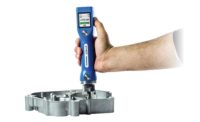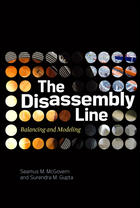Quality control measurement continues to evolve, especially as coordinate measuring machines (CMMs), 3-D measurement tools and other inspection innovations gain popularity. But handheld gages maintain steadfast places in job shops and large production facilities for both their precision and reliability.
The primary users of handheld gages are machinists during production runs, often in the automotive, aerospace and medical industries. Gages get a lot of use during the R&D process, too.
As handheld gaging becomes increasingly precise and good at collecting data, these tools become more acceptable in various measurement applications.
Handheld gages are typically one axis gages held in the user’s hand and either placed on, above, on or even inside the work piece to be measured. “Gaging-like calipers may even be flexible enough to perform multiple tasks, [such as] inside diameters, outside diameters and depth measurements, with a single product,” says Mitutoyo’s VP of Sales Michael Creney.
Handheld gaging is used to assess targeted geometric attributes to verify the agreement between the part drawing, the dimensions and the actual part being produced. For example, “fixed-limit gaging can be used to determine if the minimum and maximum product dimensions are within tolerance specified on the part drawing,” says Dan Plodzeen, president of Gage Assembly. “This type of gaging is commonly referred to as Go/No-Go gaging.”
Fixed limit gages are nonadjustable, handheld measuring tools that accommodate inner diameter (ID) and outer diameter (OD) measurement.
A Go-No gage (or Go/No Go) is an inspection tool used to check a work piece against its tolerances. It must pass one test (Go) and fail the other (No Go). It doesn’t report a size, says James J Meyer, president of Meyer Gage Co., but a state. The state is either satisfactory—where the part is within tolerance and may be used—or it is unacceptable, and must be rejected.
“It is an integral part of the quality process that is used in the manufacturing industry to ensure interchangeability of parts between processes, or even between different manufacturers,” explains Meyer. “They are well-suited for use in the production area of the factory as they require little skill or interpretation to use effectively and have few, if any, moving parts to be damaged in the often hostile production environment.”
When using fixed limit plug gages for Go /No-Go inspection, the go part should fit into the work piece to specify to the operator that the component meets the accurate specifications, Meyer says. The no-go member should not fit into the work piece. “If it does, this indicates to the operator that the component has been machined incorrectly and is out of specification,” he explains. “For this reason, when using a plug-style gage, the go gage is usually selected close but above the lower-limit size of the component and the no-go gage is usually selected just under the high limit of the component, so as to stay within the part upper and lower tolerance.”
Gaging Improvement
Handheld gages come in two forms: fixed and electronic. While fixed gages aren’t advancing as rapidly as the innovations made for their electronic counterparts, they are still seeing modern-day improvements. This is partly because new materials and coatings are readily available.
“Tool steels now are manufactured in steel mills using today’s technology to better control their content. Same goes for heat treating and stabilization processes,” says Plodzeen. “Hard chrome, tungsten carbide and other coatings are being used to extend the life of the gage.”
Digital gages are seeing a bigger range of advances, however. “Accuracy has increased, variety has been increased, but the single biggest advancement in the last 10 years has been the digital readout on these gages,” says Creney.
“This single functionality moved the world away from readout performed by operator’s skill and now the readings are displayed on an LCD. It also allowed quick conversion between the MM and inch scale by the click of a button.”
As with every type of technology, Creney says, innovation will evolve based on innovation from the manufacturer and input from the customers.
“We now have advances in inverse protection, allowing gaging to be impervious to coolant, dirt, debris and other contaminants,” Creney adds. “New innovation continues with solar powered gages, super high accuracy [such as] 0.1 um resolutions for micrometers--and advanced communications techniques, such as wireless, USB, Bluetooth and other various and ever changing methods.”
Who primarily uses handheld gaging?
Manufacturing engineers, machinists, grinding machine operators, honing machine operators, quality control inspectors or anyone involved in the manufacturer and inspection of component parts are all typical handheld gaging users.
“The users are continuing to evolve globally as manufacturers expand their operations into other countries,” says Dan Plodzeen, president of Gage Assembly. “Companies that specialize in calibration services are on the rise, so the demand for qualified technicians is also increasing. More prototyping by engineers on new products is also creating more users.”
Handheld Gaging is used in a variety of environments, including machine shops, labs and building processes. They include:
Machine shop applications, such as:
- In process manufacturing
- Periodic check
- SPC collection
- Lab uses, including:
- High precision measurement
- Data management and collection
- High accuracy single axis
- measurements
- Integrators / Fixture Builder environments, such as:
- Adding standard hand held gaging into complex fixtures (indicators, micrometer heads)
- Small size adds flexibility
- Users of handheld gaging are often prompted to use this tool because of:
- Cost / price points
- Portability
- Accuracy
- Feature Accessibility
- Data collection related
- Specialized applications, which are affordable as compared to complex 3-D geometry devices.
Economic Challenges
Although handheld gages are not a new technology, you still get what you pay for. This is important to remember, says Creney.
“In this and many other marketplaces we feel pressure from low price point inferior products that are driving down the perceived value of high quality products,” he explains. Plodzeen concurs, saying that as component parts become more complex, “the expectations of gage buyers puts the responsibility of designing and manufacturing handheld gages on the gage manufacturer to economically measure those parts.
“The cost involved to integrate today’s machine technology is great,” Plodzeen notes. “Are today’s gage buyers willing for this investment by the gage manufacturers?”




